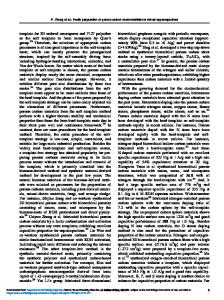Facile methodology of nanoemulsion preparation using oily polymer for the delivery of poorly soluble drugs
- PDF / 1,370,564 Bytes
- 13 Pages / 595.276 x 790.866 pts Page_size
- 32 Downloads / 402 Views
ORIGINAL ARTICLE
Facile methodology of nanoemulsion preparation using oily polymer for the delivery of poorly soluble drugs Johanna Wik 1 & Kuldeep K. Bansal 1,2 & Tatu Assmuth 2 & Ari Rosling 2 & Jessica M. Rosenholm 1
# The Author(s) 2019
Abstract Aqueous solubility of an active pharmaceutical ingredient (API) is a determining factor that has a direct impact on formulation strategies and overall bioavailability. Fabrication of nanoemulsions of poorly soluble drugs is one of the widely utilized approaches to overcome this problem. However, thermodynamic instability and tedious manufacturing processes of nanoemulsions limit their clinical translation. Therefore, this study was focused on circumventing the abovementioned hurdles by utilizing the polymer as an oil phase, instead of conventional oils. The nanoemulsion was prepared via a facile low-energy nanoprecipitation method using renewable poly(δ-decalactone) (PDL), as an oil phase and Pluronic F-68 as surfactant. The prepared nanoemulsions were characterized in terms of size, drug encapsulation efficiency, stability, and toxicity. Five different hydrophobic drugs were utilized to evaluate the drug delivery capability of the PDL nanoemulsion. The prepared nanoemulsions with sizes less than 200 nm were capable to enhance the aqueous solubility of the drugs by 3 to 10 times compared with the wellestablished Pluronic F-68 micelles. No phase separation or significant changes in size and drug content was observed with PDL nanoemulsions after high-speed centrifugation and 3 months of storage at two different temperatures (20 °C and 50 °C). PDL nanoemulsions were found to be non-heamolytic up to concentrations of 1 mg/mL, and the cell cytotoxicity studies on MDAMB-231 and MEF cells suggest a concentration and time-dependent toxicity, where the PDL polymer itself induced no cytotoxicity. The results from this study clearly indicate that the PDL polymer has a tremendous potential to be utilized as an oil phase to prepare stable nanoemulsions via a facile methodology, ultimately favouring clinical translations. Keywords Nanoemulsion . Poly(δ-decalactone) . Polymeric nanoemulsion . Stability . Aqueous solubility
Introduction Nanoemulsions are defined as dispersions of nanosized droplets of an immiscible liquid in another immiscible liquid, Johanna Wik and Kuldeep K. Bansal contributed equally to this work. Electronic supplementary material The online version of this article (https://doi.org/10.1007/s13346-019-00703-5) contains supplementary material, which is available to authorized users. * Kuldeep K. Bansal [email protected] * Jessica M. Rosenholm [email protected] 1
Pharmaceutical Sciences Laboratory, Faculty of Science and Engineering, Åbo Akademi University, 20520 Turku, Finland
2
Laboratory of Polymer Technology, Centre of Excellence in Functional Materials at Biological Interfaces, Åbo Akademi University, Biskopsgatan 8, 20500 Turku, Finland
usually being oil and water, with the aid of surfactants [1]. Nanoemulsions are widely investigated in the field of pharmace
Data Loading...











